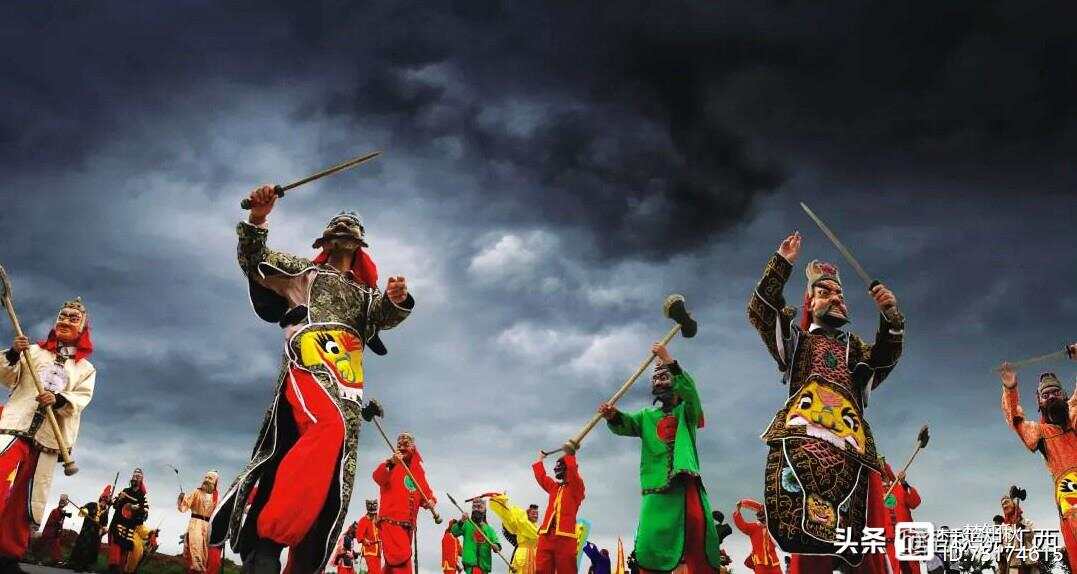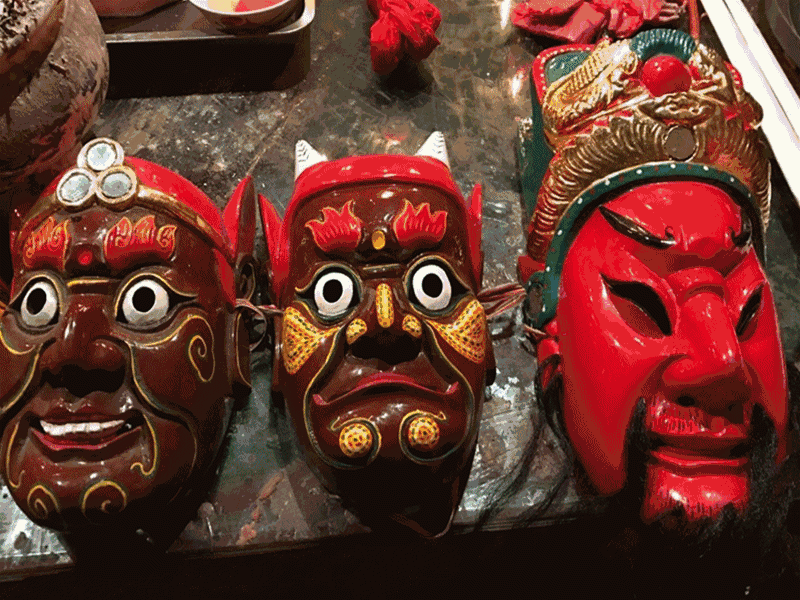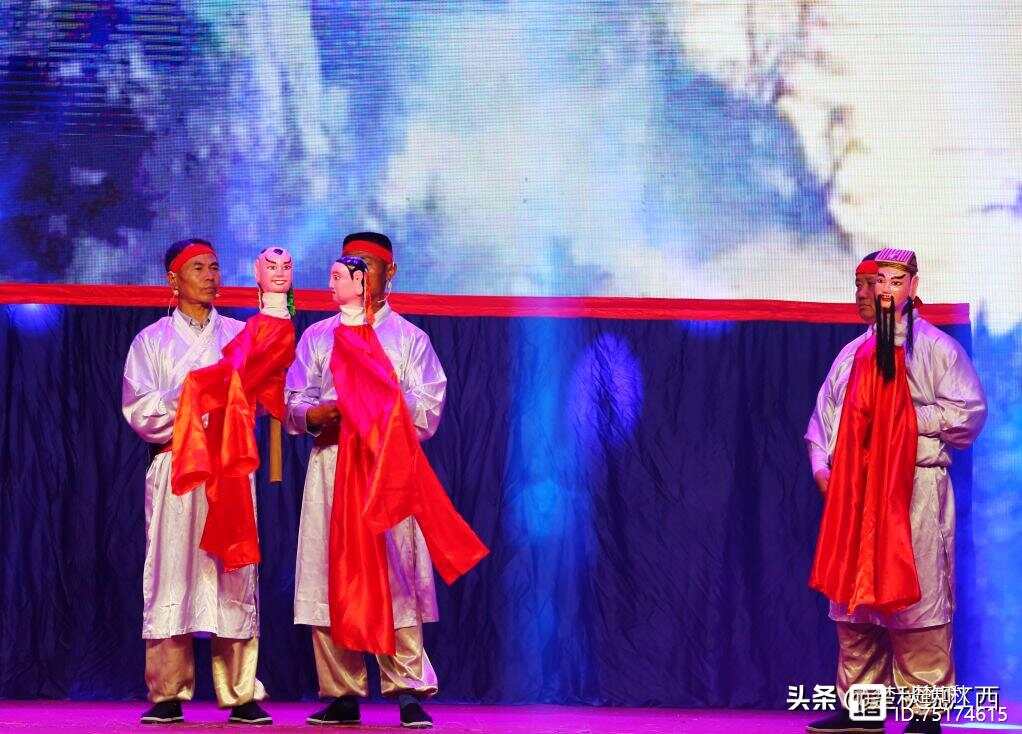As the Spring Festival approaches, every year on the first day of the Lunar New Year, men and women of all ages gather in front of the "Nuo God Temple" in Shiyou Village, Nanfeng County, Jiangxi Province, which is isolated by layers of mountains, to offer incense and worship the gods.
Three thunderous gunshots resound, followed by eight Nuo gods in ancient costumes filing into the temple through the rain, performing deep bows.

Amidst the crackling of firecrackers and the thunderous beats of cowhide drums, the Nuo gods stride out of the temple doors, disappearing into the misty rain along the village path.

This traditional ritual has been preserved in many parts of Jiangxi to this day and is an integral part of Jiangxi's Nuo culture.

Jiangxi Nuo, also known as Gan Nuo, is an important component of Chinese Nuo culture. It is renowned both at home and abroad for its long history, primitive form, rich varieties, and self-contained cultural system. It is hailed as a "living fossil" for studying Chinese and even human civilization development.


Originating from and returning to the people, what kind of magical existence is Jiangxi Nuo?
Jiangxi Elements, Jiangxi Nuo

Chinese Nuo culture has a long and rich history.
Nuo drama, as its core, originated from the exorcism rituals of the Shang and Zhou dynasties and was widely popular in provinces such as Anhui, Jiangxi, Hubei, Hunan, Sichuan, Guizhou, Shaanxi, and Hebei.

▲ Scene of Nuo performance during the Tang Dynasty
Legend has it that there were three major sacrifices in ancient China: the La sacrifice, the Yu sacrifice, and the Nuo sacrifice. Among them, the Nuo sacrifice was the most influential and grand sacrificial activity. It was divided into "Emperor's Nuo," "National Nuo," and "Great Nuo" (also known as "Rural Nuo").

Jiangxi Nuo, as an important part of Chinese Nuo culture, belongs to the category of "Rural Nuo."
As the court rituals gradually became closed and rigid, the "Rural Nuo" as a folk custom has continued for thousands of years and is still active in rural Jiangxi today.

Gan Nuo has gradually become one of Jiangxi's symbols. Originating from the Shang and Zhou dynasties, the Nuo tradition has continued for thousands of years, with traces of Jiangxi Nuo appearing in different historical periods.

Nuo God Temple in Nankeng Town, Lushi County, Pingxiang
In the early Han Dynasty, Wu Rui, a Jiangxi native and King of Changsha, stationed troops at Junshan in Nanfeng and "spread Nuo to calm evil spirits" in the western region.
At the end of the Tang Dynasty, the Yu family from Yugan County in Raozhou moved to Nanfeng to avoid war. They "invited" the Nuo god Qingyuan Patriarch, worshipped by their ancestors when they were officials in Sichuan, to Jinsha Village, establishing a temple for worship and inheriting the "Nuo exorcism" tradition.

During the Southern Song Dynasty, Liu Tang, a local resident, wrote a poem titled "Watching Nuo," which reads: "The drum sound is deep, and the pipe sound is crisp; ghosts and gods transform to provide dramatic performances."
The poem vividly describes the performance scene of Jiangxi Nuo dance drama. During the Ming and Qing dynasties, rural Nuo in Jiangxi developed rapidly, with many villages building Nuo temples and forming Nuo troupes.

To this day, many places in Jiangxi still preserve well-maintained Nuo temples and Nuo dramas.
According to statistics, from the late Qing Dynasty to the present, Nanfeng County in Jiangxi, known as the "Hometown of Nuo Drama" and the "Living Fossil of Chinese Drama," has over 150 Nuo troupes. It not only preserves Ming Dynasty Nuo God temples and ancient Nuo sacrifice rituals but also inherits more than 80 traditional programs and over 2,000 Nuo Masks, with more than 2,000 Nuo artists currently active.

Pingxiang Shangli Nuo "Worshipping Nuo God"
Shangli County in Pingxiang has been known for having "a general every five li and a Nuo god every ten li" since ancient times. Currently, it preserves more than twenty ancient Nuo temples from the Ming and Qing dynasties, inherits over 50 classical Nuo dances, has more than 400 types of ancient Nuo masks, and boasts over 20 mask carving artisans.
This has also earned Pingxiang the title of "Hometown of Chinese Nuo Culture."

Today, Jiangxi Nuo continues to be performed on the Ganpo land and has become a folk ritual worth seeing when touring Jiangxi.
At the same time, with the help of technology and cultural creativity, Jiangxi Nuo culture will be presented in more diverse forms in the new era.
Rich Varieties, Jiangxi Nuo

▲ Qing Dynasty wooden carved Nuo drama mask
The rich variety of Jiangxi Nuo is rare even within Chinese Nuo culture.
In terms of nature, there are Nuo sacrifices and Nuo arts; in terms of expression forms, there are "open-mouth Nuo," "closed-mouth Nuo," "literary Nuo," and "martial Nuo"; from an artistic perspective, there are "Nuo dramas" and "Nuo dances" complementing each other.

▲ Jiangxi Nuo dance performance
Inherited on the Ganpo land, Jiangxi Nuo presents many different content forms in various regions.
For example, the Rolling Nuo God in Le'an, Fuzhou has three different styles, such as: the "Playing Joy" in Liukeng Village, the "Head Drum Play" in Luoshan Village, and the "Rolling Nuo God" in Donghu Village.

▲ Wuyuan Nuo "The Prime Minister Commands the Army"
Another example is the Wuyuan Nuo dance, also known as "Ghost Dance" or "Dancing Ghost." Under the exaggerated masks, there's a strong shamanic color, with blessings and prayers, and a hidden aesthetic of dance art within.

Nuo God Temple in Shanggancun, Nanfeng
The Nuo dance in Nanfeng, Fuzhou is another example, with 113 troupes including "Jumping Nuo," "Jumping Bamboo Horse," "Jumping Harmony," "Jumping Eight Immortals," and so on, which can be considered extraordinary.
In addition, Chongren has "Face Turning" and "Jumping Eight Immortals," Yihuang has "Jumping Nuo," Guangchang has "Meng Drama" and "Jumping Kuixing," Lichuan has "Jumping Harmony" and "Jumping Eight Frames," and Fuzhou, Nancheng, and Jinxi also have records of Nuo customs.

Nanfeng Nuo "Nanfeng Jumping Nuo"
In western Jiangxi, Pingxiang is the most prominent. The TV documentary "Dreamlike God - Ancient Pingxiang Nuo" accurately presented the grand spectacle of Pingxiang Nuo.

▲ Yongfeng Nuo "Old Woman Delivering a Child"
Pingxiang Nuo is locally called "Yang Nuo Shen" (Yang means dance or jump in the local dialect), "Shua Nuo Shen," "Shua Nuo An," "Cen Nuo Shen," and in some places, it's called "Cai Nuo" or "Cai Nuo An" because the dance steps must coincide with the gong beats.
The types of programs are complex and diverse, each being exquisite and rich.

▲ Wanzai Nuo "Celebrating the Lantern Festival"
This is why Pingxiang is known for having "a general every five li and a Nuo god every ten li."

Nuo culture performance
In Yichun, there are distinctions between "closed-mouth Nuo," "open-mouth Nuo," and "side-narrative Nuo." Wanzai calls it "Jumping Xian" or "Moving the Case," divided into "closed-mouth Nuo" and "open-mouth Nuo" schools. Gaoan and Shanggao have "Expelling Plague," while Jingan and Fengxin call it "Dusting Nuo"... In Suichuan, Ganzhou, the "Bull Fighting Dance" is popular.

▲ Jiangxi De'an Nuo "Pan Taigong's Spring Outing"
Northern Jiangxi is also covered with traces of "Nuo." In Xiushui, it's called "Performing Nuo," in Wuning they sing "Nuo Songs," De'an has "Nuo Rituals" and "Pan Gong Drama," Ruichang has "Divine Nuo," Duchang calls it "Expelling Plague," and in Pengze, "Chasing Flower Cats" is a Nuo custom.

▲ Hakka Nuo "Ningdu Zhongcun Hakka Nuo Drama"
Besides these, Ningdu, Ruijin, Nanchang, Xiajiang, Zhangshu, Fengcheng, Fuling, Shangrao, and other places all have their unique Nuo cultures and performances, collectively forming the rich and colorful Gan Nuo cultural group.

Jiangxi Nuo with profound cultural heritage

Colorful Jiangxi Nuo
Carving Art, Nuo Masks

Nuo masks are an important component of Nuo culture and also symbolize and embody deities.
The artisans who carve masks are called "Chushi," and there are many customs and taboos when making masks, which further adds a sacred color to the "Nuo masks."

Displayed Jiangxi Nuo masks

Nuo mask making
Killing a chicken and smearing its blood on the mask, "enlightening" the forehead and eyes, placing tea leaves, lamp wicks, rice grains, and medicines in the small square hole carved at the top of the mask, and so on.
Every step seems to be a continuation of ancient traditions and filled with reverence for the "deities."

Pingxiang Xiangdong Nuo masks

Various forms of Nuo masks
The lifelike images of various gods carved out are a concentrated embodiment of carving art, ancient and delicate, complex yet particular, which can be regarded as an invaluable cultural heritage in China's carving field.

Various Jiangxi Nuo masks

Cute Nuo masks
There is much more to say about Jiangxi Nuo. This is how Jiangxi Nuo is - originating from the people and returning to the people. In this process, it has been passed down from generation to generation, blooming on the Ganpo land and spreading to the world.
It is ancient, carrying the continuation and expectation of thousands of years of culture; it is also sacred, sacred enough to inspire awe.

Worshipped Jiangxi Nuo Gods
As the "Analects of Confucius · Xiang Dang" says: "When the villagers were exorcising the pestilential influences, he put on his court robes and stood on the eastern steps." Even Confucius, who avoided talking about ghosts and gods, solemnly wore court dress and stood on the eastern steps of the hall to welcome the villagers' Nuo.

This sacredness is self-evident, which is why Nuo has always been a god-like existence on the Ganpo land.
It is also of the common people, growing quietly among the folk and being revered by people.

On important festivals, especially from the Beginning of Spring to the first month of the lunar year, "bamboo horse, big Nuo, harmony, lion dances, wearing colorful clothes and masks to dance," gongs and drums everywhere, every household "jumping Nuo," hundreds of villagers bringing out lanterns and joining the Nuo troupes and drama troupes to tour villages and fortresses - these scenes are the best testament.


It represents people's awe for nature and deities, and more importantly, it represents people's good wishes for blessings and auspiciousness.

As times evolve, Nuo culture is also being preserved, continued, and inherited.
In today's increasingly prosperous modern technological civilization, the rustic Nuo masks and primitive dances that record the ancient genes of Chinese civilization exude a unique charm.

Similarly, this is also a unique flavor of the New Year and nostalgia on the Ganpo land.
